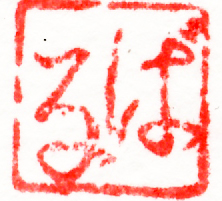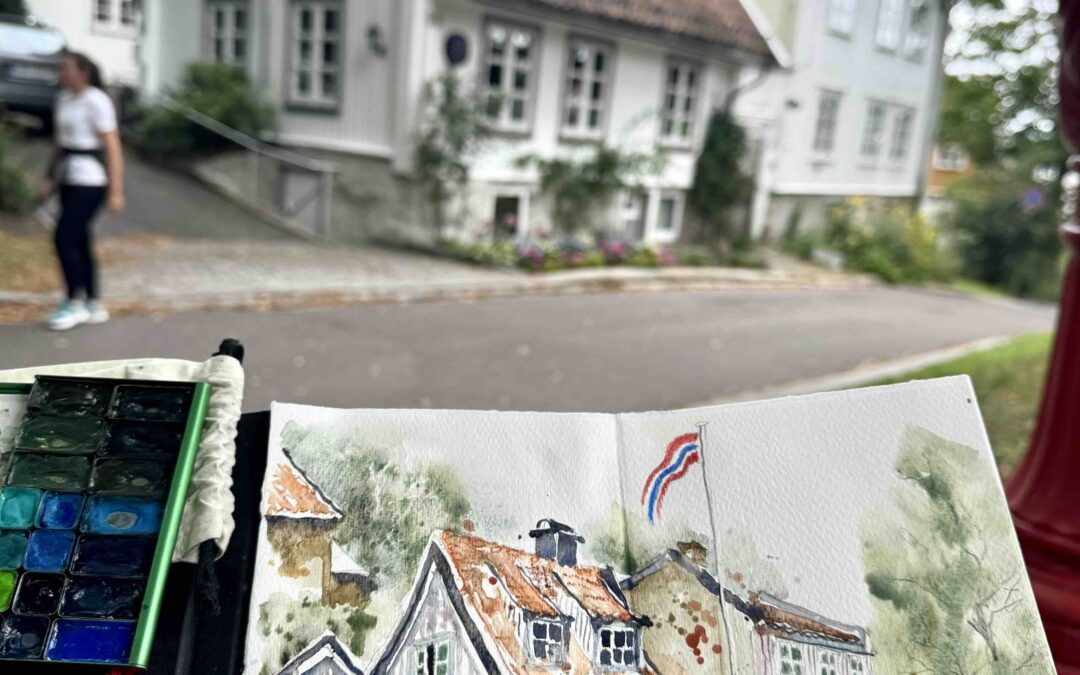Which size of Sketchbook do you use? Do you vary sometimes or stick to one type of sketchbook? For years I’ve been always sketching in the same (Moleskine) watercolor sketchbook, A5 size, because I wanted to end up having my shelves filled with them like other sketchers had. I thought they looked great. But then I discovered that other sizes worked better for my way of drawing, and other paper as well…
If you’ve found yourself frozen when you start sketching something, the problem might not be your abilities — it could be your sketchbook’s size.
I just came back from Norway and now I’m preparing for the urbansketching symposium in Poznan and wondering what sketchbooks to take.
To Norway I took 4 differents sizes of sketchbooks.
Size matters….
According to the subject, I choose a different size and shape…. But also a different paper…
The Impact of Sketchbook Size: Your paper’s size influences everything — your perspective, your choices about what to draw, and your creative confidence and freedom of movement.
Compact sketchbooks offer comfort and familiarity. They slip easily into a pocket, invite quick drawings, and don’t demand complete coverage.
Large sketchbooks provide room and possibility. Freedom — though they can seem daunting initially. All that empty space might feel challenging, particularly when you’re developing your skills.
Note to Self: it’s not merely about the surface. It’s about your mindset when facing it.
Advantages of Larger Formats (A3 or even A2) Big sketchbooks let your concepts expand. They excel for:
- Sketching complex cityscapes
- Experimenting with multi-layered drawings incorporating various tools and mixed media
- Sketching large natural landscapes like in Norway…
A tip I find helpful: Before sketching, “draw” the main shapes first with your finger on the paper, to see where you will put down your lines and to see how big you will make your drawing — like a rehearsal. This helps you plan your composition and to fit everything in what you want to fit in
Compact Sketchbooks A4 and smaller formats are ideal for:
- Drawing while traveling or walking around
- Focusing on details — a tea cup, a cinnamon roll 😉 , a door or window
- If You prefer quick, informal drawings
- If You’re concentrating on single elements
Brands:
- My large sketchbook is of the brand Extinto.es . It has Fabriano Academia 200gm paper and size 27cm x 32,5cm: https://extinto.es/products/extinto-xl-por-maru-godas
- The medium one is made by Will J Bailey : https://willjbaileyshop.com/collections
- The smaller one is by Fabriano
- And the tiny mini leporello is by the Portuguese brand Inusitado : https://www.inusitado.pt/shop/p/imergir-emergir-leporello
Suggestion: With limited space, pick just one detail to draw. Leave other areas suggested, partial, or blank.
But anyway: The essential truth? Work with whatever’s available and begin drawing. Whether large or tiny, each drawing moves you ahead. An opportunity to experiment, discover, and develop — not only your drawing muscles and skills, but your creative spirit.
You don’t have to sketch perfectly.
You just have to sketch.
In the video below I show you the sketchbooks I worked with in Norway.


I prefer A5 (landscape more often than not). I can adjust my sketch and often can get a whole building or a short street scene in.
Ha! I consider A4 large… especially when I use both sides, doubling my coverage. I use them most often if I am visiting a place with a story to tell, so that I am doing a large sketch and may have smaller supporting sketches, such a place and a portrait of the owners.
I’m not a fan of Moleskin since they changed their paper, and especially as the paper feels different from one side ot the other. I’m finicky about the paper. I’ve tried several brands and like Hanemuhle best.
Thank you Kate!
It’s true that at a certain moment Moleskine changed the paper. That’s also when I stopped using them…
Merci Barbara. Très intéressant pour moi qui aime dessiner pendant les voyages . Je me demande si le grammage du papier est tout 300g ou un peu de tout. C’est peut être mieux pour ces sketch book de choisir 300g?
Bonjour Yoshiko
C’est difficile de trouver des carnets avec du papier de 300gr
Si tu ne mouille pas beaucoup le papier, 300gr n’est pas vraiment nécessaire …
le plus petit est 225gr je pense, et le plus grand est 200gr
I love the tiny sizes, although I also use, a lot, A5
You’ve begun the tiny one in Portugal or you bought it here? I’d love to know the brand if you’ve bought it here.
Although it’s an idea to make one.
I enjoy to read your blog
Hi Teresa
the tiny one was bought by a friend in Portugal…
I don’t know the brand anymore and can’t read it on the sketchbook.
I try to find it again…
Thank you so much!
Hello Teresa!
I added the brands and found the brand of the tiny one. It’s made in Portugal (I didn’t use it in Portugal).
The tiny mini leporello is by the Portuguese brand Inusitado : https://www.inusitado.pt/shop/p/imergir-emergir-leporello
This is so interesting! I have always used larger sketchbooks and brought a smaller, Arches Carnet de Voyage with me to France. I loved being able to focus and found that I filled it up in two weeks by sketching at least once a day. When I got back I bought another small one — 5 x 8 from Hannemuhle — and now it seems too small. I’m going to try the Moleskin next on your recommendation. My frustration sometimes comes from the paper quality and wanting more durability! Thanks as always for your suggestions and inspiration!
thank you so much Elizabeth!
very interesting. I need to get back to sketching daily. Even small….just start.
Yes Linda: just start! The more you do it the better it gets!
Interessant om zien wat formaat kan doen met een tekening! Kan je meer details geven over je schetsboeken I.v.m. waar ze te koop zijn. Tekenwinkels in mijn buurt hebben ze niet altijd in voorraad.
Dank je Chantal!
Ik heb wat extra informatie toegevoegd in het artikel
Thank you for the information on the sketchbooks and thanks for the peak at all your beautiful work! I love how you paint-very inspiring!
Thank you so much Denise!